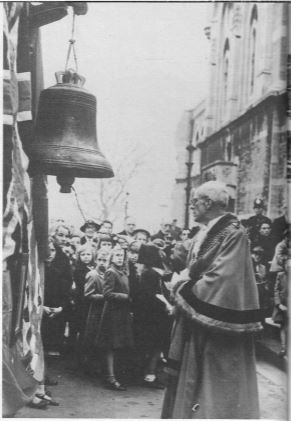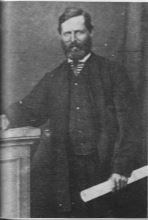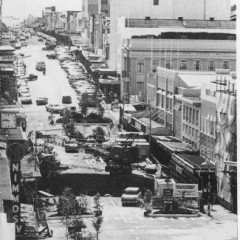6:5
it was also a personal triumph for Carrington, himself no stranger to narrow and selfish interests.' As the New Zealand Company's surveyor his first three years in the colony had been dogged by disputes with his superiors, resulting in his dismissal and ignominious return to England; but on his return as Provincial Superintendent, the province's rep- resentative in Wellington, and first chairman of the harbour board, he had worked assiduously for such a day. As work on the breakwater progressed there was great opposition from many quarters: Other provinces vehemently protested in the House, or ridiculed through their Press, against public expenditure in Taranaki; debates were acrimonious and at times personal. The province itself divided-Waitara wanted its own river developed, Hawera looked to Pate a for an outlet and objected to being rated for distant New Plymouth ... and even little Opunake frittered away many thousands of dollars on a harbour scheme now quite defunct. In New Plymouth itself, the financial depression of 1880 also embarrassed the harbour board at the moment of greatest expenditure. Workmen agitated for sustenance jobs to begin in spite of disorganised and uncompleted plans, and board members (themselves in local business and highly susceptible to public pressure) embarked on premature work against the clear advice of their engineers. Members of proven integrity resigned; competent engineers were dismissed and at the most crucial stages of construction, while local amateur inventors pressed the claims of their impracticable model breakwaters and agitated publicly for their acceptance. Paltry economies were practised to no useful purpose. Two costly engineering investiga- tions were allowed to languish, and a faulty third (by a London engineer of eminent authority) was actually embarked upon, only to be abandoned when its continuance was seen to be quite disastrous. The finances were also muddled. Government votes were expended before a single stone was laid; an issue of debentures yielded less than expected, and at last defaulted upon its coupons; auditors found discrepancies in accounts and costs greatly exceeded estimates ... 21 Carrington had arranged with the Government in Wellington that it would relieve the local authority of both the expense and responsibility of the construction of a harbour which it proposed to carry out with the use of convict labour-a central prison was proposed for Moturoa-but his scheme foundered on local opposition to the presence of convicts in large numbers in New Plymouth. Carrington fought to save his scheme, the failure of which meant that New Plymouth must provide its harbour out of its own meagre resources.s- In spite of all this, work on the breakwater proceeded. During its construction ships could shelter behind it, and in 1884 the Wanaka (493 tonnes) was the first steamer of size to tie up alongside. But, the breakwater was found not to be wholly satisfactory for berthing ships and in 1887 the Moturoa Wharf was built.
In 1917 Taranaki Harbour 'became of age' with the sailing of the Waiwera (6273 tonnes), the first ship to be loaded with produce for London. The Newton King Wharfwas built in the early 1920s; the main breakwater was extended and a lee breakwater built in the 1960s; the Blyde Wharf (named in honour of Sir Henry Blyde, board chairman from 1953 to 1974) was built, and container handling facilities were provided in 1978.
For George Cutfield, a one-time naval architect in England and leader of the first contingent of settlers aboard the William Bryan, it seemed that one of the greatest needs of the new settlement, apart from a harbour, was a ship which the settlers could use to meet the demand of the 1850s to supply the gold-diggers of Australia with Taranaki potatoes and other exportable produce. He had brought with him a model of a revenue cutter which he had designed while employed in the British naval dockyard at Devonport, and in 1853 he and several other prominent men combined resources to build a modification of the cutter. A 'shipyard' was built just above high-water mark to the west of the present Pioneer Road, on which the keel was laid. Building, by Messrs Rundle and Clark, took 18 months and the 100-tonne vessel, named Taranaki, comprising mainly ad zed rata, was launched on April 9, 1855, with settlers flocking to the beach on horseback and in bullock carts as if it was a general holiday. Her first cargo was a few tonnes of flour and butter to be off-loaded at Wellington. She sailed on April 28, and her first port of call was Nelson which she reached four days later. she was unable to enter Wellington Harbour because of a storm and was driven up the east coast, eventually to make Auckland where extensive damage to rigging and sails was repaired. Another gale took her half-way across the Tasman before she reached New Plymouth, where she loaded more produce before leaving for Wellington again. This time the elements were kind and she arrived there on July 5, 10 weeks after setting out. Her commander was Captain Clouston, who later became governor of Nelson Gaol. Her maiden voyage had proved she could handle most weather New Zealand coasts supply, but she was an uneconomic performer and Cutfield and his syndicate sold her. She sailed for several years on the Australian coast and was lost during a trip to the islands. Her name, however, was not lost. Another Taranaki, a steamer of 443 tonnes, was built in Scotland in 1865 for the Union Steam Ship Company. She was a familiar coaster for 13 years until she was wrecked on November 28, 1878, on rocky Kawera Island between Katikati and Tauranga.P Later another Taranaki, a clipper, belonged to Shaw Savill, and in the 1940s the same company's motor ship of the same name was a frequent visitor to New Zealand ports. And on October 28, 1961, the Royal New Zealand Navy's frigate Taranaki, on her maiden voyage,


